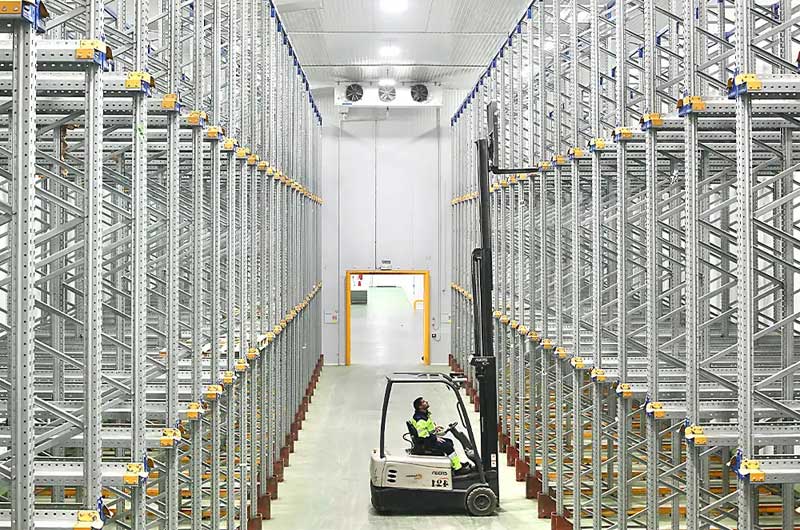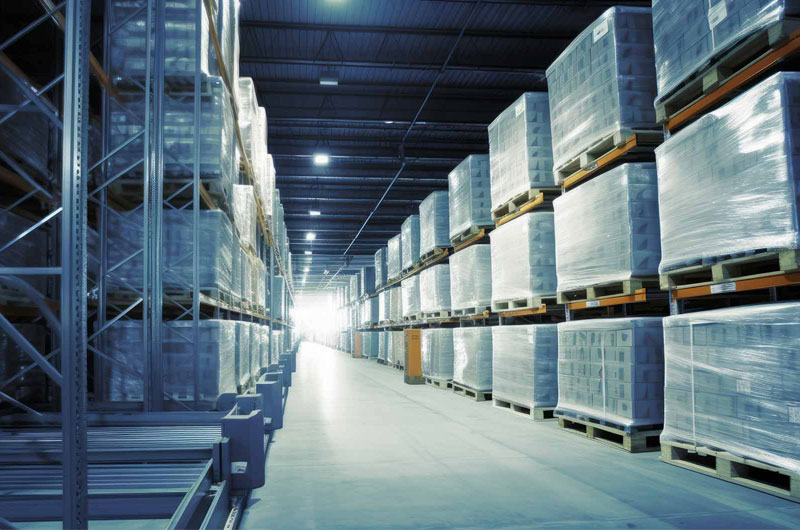For high-throughput warehouses in particular, where large volumes of perishable goods are moved daily, a well-designed cold room layout is critical to ensure operational efficiency, energy savings, safety, and compliance with regulatory standards.
Now, we will explore the common layout types for cold rooms in high-throughput warehouse environments.
1. Understanding High-Throughput Warehousing
High-throughput warehouses are designed for speed and volume. These facilities process thousands of units per hour with rapid inbound and outbound logistics. In such settings, time is of the essence. Inefficient layouts can lead to delays that impact product quality and interrupt supply chain operations.
For cold storage, the complexity increases due to the need for consistent temperatures and humidity levels, fast turnover of perishable goods, and the integration of material handling systems that can perform efficiently under low-temperature conditions.
2. Objectives of an Efficient Cold Room Layout
When designing cold room layouts for high-throughput warehouses, the layout must satisfy several critical objectives:
- Maximize Space Utilization: Vertical and horizontal space must be used effectively, considering racking systems, aisle widths, and load-bearing capacity.
- Minimize Product Handling Time: Streamlined flow from receiving to storage to dispatch reduces energy usage and labor costs.
- Ensure Temperature Integrity: Temperature zoning should be considered to accommodate different product requirements.
- Facilitate Automation Integration: The layout must accommodate automated systems such as AS/RS, conveyor lines, and robotic equipment.
- Enhance Worker Safety and Comfort: Clear pathways, anti-slip flooring, and ergonomic design are vital in cold environments.
- Energy Efficiency: Strategic placement of doors, air curtains, and insulation zones helps retain cold air and reduce operational costs.
3. Key Considerations in Cold Room Design
a. Temperature Zones
Cold rooms in high-throughput warehouses often have multiple temperature zones:
- Chill Zone (-5°C to 5°C): For fresh produce, dairy, and pharmaceuticals.
- Freezer Zone (-18°C to -15°C): For frozen meats, seafood, and ice cream.
- Blast Freezer (-25°C or lower): For rapid freezing of incoming goods.
Zoning allows the facility to store a wide range of products under ideal conditions and minimizes energy waste by not overcooling.
b. Racking Systems

Choosing the right racking system is crucial:
- Selective Racking: Good for high SKU counts with regular picking.
- Drive-In/Drive-Through Racking: Suitable for bulk storage and Last-In-First-Out (LIFO) or First-In-First-Out (FIFO) systems.
- Mobile Racking: Increases storage density by using movable racks on tracks.
- Pallet Flow Racking: Gravity rollers are well-suited for FIFO systems, advancing pallets automatically for smooth flow.
Automation-compatible racks also support high throughput by facilitating AS/RS and shuttle systems.
c. Material Handling
Cold environments affect machinery and workers, so material handling solutions must be robust:
- Cold-rated forklifts with heated cabins.
- Automated Guided Vehicles (AGVs) and conveyors designed for sub-zero operations.
- Dock seals and airlocks to minimize temperature fluctuation during loading/unloading.
4. Types of Cold Room Layouts
a. U-Shaped Layout
Design: Inbound and outbound docks are on the same side, with storage in the rear forming a U.
Advantages:
- Minimizes travel time for goods.
- Compact footprint ideal for smaller facilities.
- Easy access to storage and dispatch.
Disadvantages:
- Congestion risk near docks.
- May limit future expansion.
b. Through-Flow (Linear) Layout
Design: Receiving is on one end, storage is in the middle, and dispatch is on the opposite end.
Advantages:
- Streamlined flow supports FIFO and high-speed operations.
- Reduces risk of cross-contamination.
- Excellent for automation integration.
Disadvantages:
- Requires a longer facility footprint.
- Higher initial construction costs.
c. L-Shaped Layout
Design: Inbound and outbound docks form an “L” with storage connecting them at a corner.
Advantages:
- Separates incoming and outgoing traffic effectively.
- Ideal for multi-temperature zones.
- Easier dock management.
Disadvantages:
- Can be inefficient for ultra-high throughput unless carefully optimized.
d. Modular Zoning Layout
Design: Multiple temperature-controlled rooms or zones are arranged modularly within the warehouse.
Advantages:
- Maximum flexibility for various temperature and product types.
- Facilitates phased construction and expansion.
- Reduces cross-temperature contamination.
Disadvantages:
- May increase internal transport time.
- Requires efficient routing and workflow management.
5. Best Practices for Cold Room Layouts in High-Throughput Warehouses
a. Use Airlocks and Strip Curtains
Installing airlocks between ambient and cold zones minimizes heat gain and prevents condensation and icing. Strip curtains and high-speed doors further help retain cold air during busy loading periods.
b. Optimize Aisle Widths
Balance is key: wide enough for safe forklift maneuvering but narrow enough to maximize pallet positions. Standard aisle widths range between 2.8 to 3.6 meters depending on forklift type.
c. Prioritize FIFO with Racking and Flow Design
Proper flow of goods is critical for perishables. Racking and layout design should reinforce FIFO practices to preserve quality and minimize spoilage.
d. Incorporate Real-Time Monitoring
Sensors, RFID, and warehouse management systems (WMS) allow real-time tracking of temperature, inventory movement, and energy consumption. These systems minimize operational downtime and help maintain compliance with industry regulations.
e. Plan for Maintenance Access
Design layouts with clear access paths for equipment maintenance, defrosting, and emergency exits to avoid disruptions.
6. Technology Integration in Cold Room Layouts
Modern cold rooms are increasingly integrated with advanced technologies that boost throughput and reduce errors:
- AS/RS: Reduces labor and speeds up storage/retrieval.
- Automated Conveyor Systems: Move products swiftly across zones.
- Warehouse Management Systems (WMS): Coordinate order picking, track inventory, and direct AGVs.
- IoT Sensors: Provide alerts for door status, temperature fluctuations, and equipment faults.
- AI Optimization Tools: Predict storage requirements and optimize layout over time based on traffic and inventory data.
7. Safety and Compliance Considerations
Worker safety in cold environments is paramount:
- Anti-slip flooring and insulated PPE are essential.
- Clearly marked emergency exits and fire-rated insulation are required by most codes.
- Compliance with standards such as HACCP, FDA, and EU regulations must be factored into the layout from the beginning.
Regular audits, staff training, and proper signage further enhance safety and efficiency.

